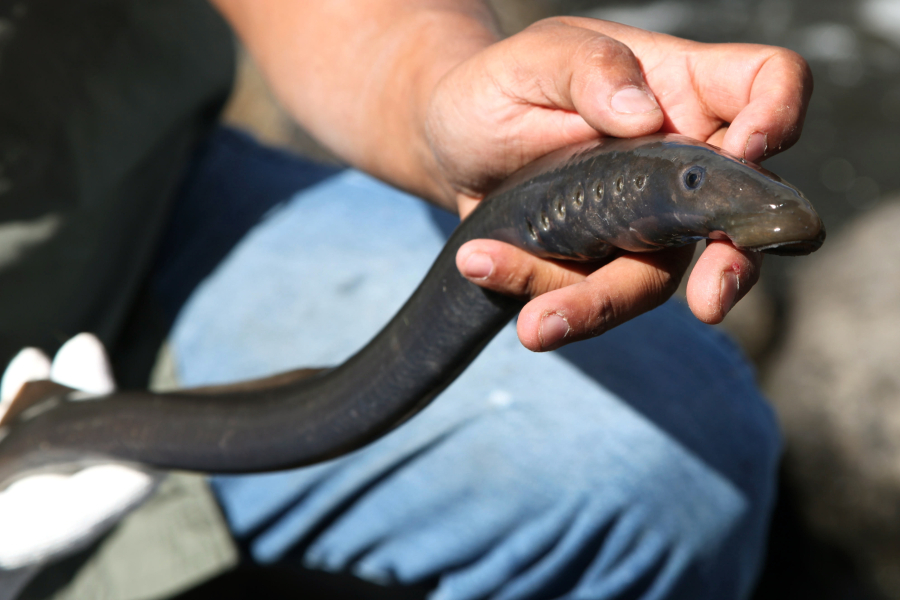An ancient species, Pacific lampreys have survived five mass extinction events. Now populations of these fish found in the Columbia River are facing a sharp downturn.
Before 1970, counters at Bonneville Dam annually tallied more than 106,000 adult Pacific lampreys. Recently the count diminished to 30,000 fish, according to a 2022 Pacific lamprey regional implementation plan.
Like other fish in the Columbia River, Pacific lamprey populations are declining from habitat degradation, passage barriers and shifting water quality, whether through pollution or rising temperatures.
The sight of the eel-like creature may be off-putting at first. But, “It’s not hard to fall in love with lamprey,” said Monica Blanchard, Washington Department of Fish and Wildlife lamprey biologist.
Blanchard, who began her career focusing on salmon, developed an adoration for Pacific lamprey once she began learning about them. In part, she admires their role in maintaining balance in the region’s ecosystem.
Pacific lampreys act similar to earthworms, softening streambeds and adding nutrients while filtering out harmful organisms from aquatic systems, she said. Lampreys dislodge invertebrates and algae when shifting rocks to make nests, increasing food availability for other creatures that dwell in streams.
Lamprey bodies are calorically dense – roughly three to five times more by weight than salmonoids — and are a critical component for both freshwater and saltwater species’ diets. Larvae and juvenile lamprey serve as a “distraction” of sorts, serving as a predation buffer for salmon.
They are among the last remaining jawless fish belonging to the Agnatha superclass — the other being hagfish — with three of 40 current lamprey species living in Washington.
Lacking publicity
There’s another prime component contributing to lampreys’ decline: they are poorly understood. Partly it’s because these writhing eel-like fish with circular, toothy mouths lack the charisma of salmon and steelhead.
And lampreys get a bad reputation because of their parasitic way of feeding, Blanchard said. As adults, these jawless fish latch onto fish and whales to feed on their bodily fluids, something that happens when they reach the ocean.
Lampreys won’t bore into humans. If they do suction onto a person, she continued, it’s because they feel most content holding onto something. A gentle tug will promptly pop the fish off.
“We joke that a big part of our job when we’re talking about lamprey is PR management,” Blanchard said, adding that often fisheries science is centered on a fish’s charm.
U.S. Fish and Wildlife researchers have even published an academic report touching on the imperativeness of dispelling public rejection of native lampreys in the Pacific Northwest.
That’s one reason why Blanchard carries a vial of lampreys’ small keratin teeth — something they naturally shed as a means of upkeep — to show grade-schoolers. She tells them about the “coolness” of Pacific lampreys’ origin that began more than 450 million years ago – predating the evolution of trees and dinosaurs.
“Kids haven’t had that time to associate parasites as a negative thing as most adults do,” she said. “They’re not too scary.”
When did this mentality that lamprey are frightening begin to form?
In the early- to mid-1900s, sea lampreys plagued the Great Lakes’ freshwater fisheries after accessing human-made canals, feeding on lake trout and whitefish populations and eventually damaging their populations.
In 1955 the U.S. and Canada formed the Great Lakes Fishery Commission. The commission launched aggressive control programs and villianized sea lamprey. Doing so inadvertently spread this loathing nationwide, uniformly stamping all lamprey species with an undesirable label.
What’s being done?
The State Wildlife Action Plan identifies Pacific lamprey as critically imperiled, or in need of robust conservation efforts. Washington Fish and Wildlife tags it as a priority species that requires equally robust protective measures.
Lampreys are considered imperiled in most of Washington’s watersheds, including most of Southwest Washington’s tributaries, Blanchard said. The lower Cowlitz River hosts the strongest Pacific lamprey population, though it’s still considered to have low lamprey populations.
Pacific lampreys are important to regional tribes, who served this fish alongside salmon during ceremonies, according to the Columbia River Inter-Tribal Fish Commission. Tribes of the Columbia River Basin were also the first to recognize the need to advocate for lampreys.
Research and conservation efforts in Western Washington and the lower Columbia River have ramped up in recent years, though there are data gaps along the coast and Puget Sound.
“In the lower Columbia, there’s been a big push in the last several years to really think about the threats that exist from a lamprey lens rather than just the salmon-steelhead perspective,” Blanchard said.
Washington Department of Fish and Wildlife is a part of the Pacific Lamprey Conservation Initiative, a partnership between regional local, state and federal agencies, tribes and nongovernmental organizations from Alaska to California.
Biologists are just beginning to understand lamprey on a statewide scale and are making noticeable strides, chiefly with the creation of its regional 2022 implementation plan and ongoing partnerships.
Anyone who is interested in learning about Pacific lamprey can help with its conservation.
There are information workshops offered by local groups, such as the Lower Columbia Estuary Partnership, and occasional watershed walks hosted by state agencies. More importantly, Blanchard said, being aware of one’s ecological footprint and acting sustainably when possible will lead to positive movement.
What matters is that people stay engaged.
“Humans have greatly impacted them,” she said. “It’s a lot to reflect on, what we’ve done to these fish who have lasted through that.”




